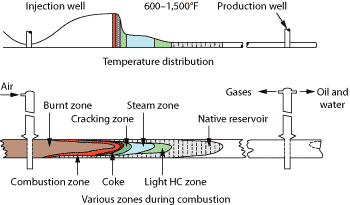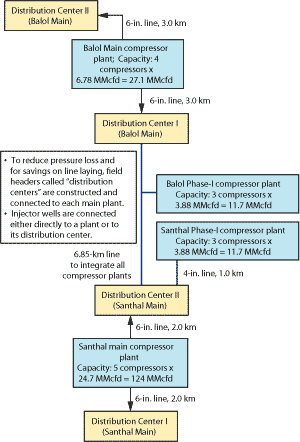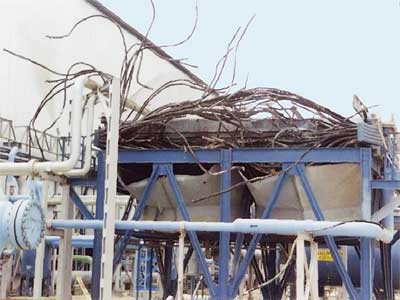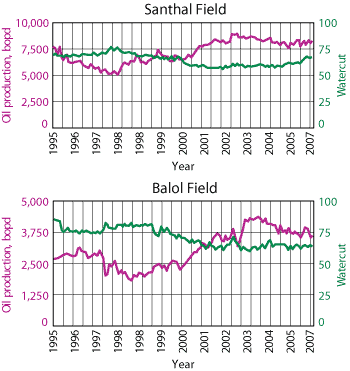In situ combustion delivers results
An EOR method involving injection and ignition of compressed air in the reservoir increased the oil recovery factor threefold in India's Mehsana heavy oil belt.
SPECIAL FOCUS: PRODUCTION TECHNOLOGYIn situ combustion delivers results
An EOR method involving injection and ignition of compressed air in the reservoir tripled the oil recovery factor in India’s Mehsana heavy oil belt and provided valuable lessons for future projects.Pankaj Gupta, Adabala Doraiah and Sibaprasad Ray, Oil and Natural Gas Corporation Ltd., Mehsana, India. At Balol and Santhal heavy oil fields in the Cambay Basin, India, high mobility contrast between viscous oil and water resulted in low primary recovery, and subsequent artificial lift caused high production of water rather than oil. To increase oil production, the operator implemented in situ combustion, a thermal Enhanced Oil Recovery (EOR) process. The technique involves ignition in the well and injection of air to sustain a flame front that travels from the injection well to production wells. In this process, a small quantity of in situ oil burns (rapidly oxidizes), producing carbon dioxide, water vapor and heat, which lowers the oil’s viscosity, increases its mobility and displaces it toward the surrounding producers. ONGC Mehsana implemented in situ combustion on a commercial scale in 1997 at Balol and Santhal Fields. The technology has given the fields new life, tripling the oil recovery factor. Production engineering for in situ combustion requires careful planning and monitoring. A discussion of the major issues that were dealt with during this application may be helpful for successful planning and implementation of new projects. INTRODUCTION Oil and Natural Gas Corporation Ltd. (ONGC) is India’s biggest integrated oil company. The Mehsana asset, in the northern part of Gujarat state, is the company’s highest oil-producing onshore asset, with annual crude oil production of about 16.2 million bbl. Fields in Mehsana produce both the heaviest crude and one of the lightest crudes in India, with gravity ranging from 13 to 42°API. Heavy oil fields discovered in 1970-71 at Mehsana belong to northern part of the Cambay Basin. They include Santhal, Balol, Lanwa and Becharaji Fields, covering a total area of about 70 km2 and containing about 982 million bbl OOIP. Heavy oil exhibits gravity less than 20°API. It is characterized by high viscosity, low hydrogen-carbon ratios, low gas-oil ratios and significant content of asphaltenes, sulfur and heavy metals. In short, heavy oil reservoirs generally present low-energy and low-productivity wells. These characteristics make recovery challenging. Balol and Santhal are two major fields of the heavy oil belt, bearing oil with gravity of 15-18°API. These fields have OOIP of 146 million and 353 million bbl, respectively. The crude is asphaltic in nature, containing 6-8% asphaltene, and has viscosity ranging from 50 to 450 cP in reservoir conditions. Reservoir pressure and temperature are 1,400 psi (9.8 MPa) and 70°C, respectively, at 3,200 ft (990 m) below mean sea level. The reservoir has permeability on the order of 3-8 D and operates under water drive. High mobility contrast between the viscous oil and water resulted in primary recovery of less than 13%. Moreover, application of artificial lift caused increasing water production, which rose to 95-100% in some wells and forced some well closures. The poor primary recovery and ineffective artificial lift spurred a search for a suitable EOR method to improve ultimate recovery from these fields. In situ combustion was one of the methods considered. IN SITU COMBUSTION In situ combustion is an EOR technique used to produce heavy oil. The process is based on the principle of heating the crude within the reservoir using part of the reservoir oil as fuel for combustion, Fig. 1. Hot air is injected into the reservoir for a pre-determined period of time, with the help of gas burners or electric heaters lowered into the well. The air provides the formation with oxygen needed to rapidly oxidize the oil in the reservoir, forming carbon dioxide and water and releasing heat, the quantity of which depends on the crude oil composition. Combustion is sustained by continuous air injection into the formation.
This method can be quite efficient, as a small amount of the heavier fraction of in-place oil is consumed while the rest is displaced toward producers. The process assists production in multiple ways: In addition to the heat generated, the CO2 produced forms a gas cap that adds pressure to reservoir, assisting gravity drainage, while the combustion gas dissolves in the oil, thinning it and stripping it from the sand grains. To exploit the enthalpy of the burnt sand behind the advancing combustion front and to improve the sweep efficiency, a 1-day waterflooding phase is carried out after every 6 days of air injection. MEHSANA APPLICATION Production from the Mehsana heavy oil fields was a challenge. Based on internationally accepted screening criteria and the results of laboratory studies at ONGC’s Institute of Reservoir Studies, in situ combustion was identified as the most suitable technique for enhancing recovery from these fields. The method was first used in the asset on a pilot scale in Balol Field in 1990, with the help of a foreign consulting firm. Pilot schemes. A pilot test was designed and initiated in a 5.5-acre area of the southern part of Balol Field in 1990-91. Wells CP-10 and, thereafter, Balol-171 were ignited with the help of foreign experts. The sustained combustion and production gain from nearby producers led to conceptualization of commercialization schemes in the entire Balol Field. Another pilot scheme was designed for Lanwa Field, and an inverted five-spot pattern with four producer wells was ignited in 1992. Commercialization of the scheme is in progress to enhance production from the field. A pilot program is also running since 2002 in Bechraji Field with four EOR injectors. Commercial application. Based on the encouraging results of the Balol pilot project, commercial EOR schemes were designed for the entire Balol Field. Considering the similarities between the Balol and Santhal Fields, it was decided to implement in situ combustion in Santhal Field also, and commercial implementation commenced on both fields in 1997. Four commercial schemes (Balol Phase I, Santhal Phase I, Balol Main and Santhal Main) were implemented, each using one large air compressor plant. These plants supply compressed air at reservoir conditions to the EOR injector wells, which are mostly old producers that have been converted. Except for the diesel-powered emergency air compressors, all compressors run on electricity. The four plants have a combined installed capacity to compress 170 MMcfd (4.9 MMcmd) of air at a maximum pressure of 1,750 psi (12.1 MPa). Produced water is treated at facilities in each plant and re-injected during the waterflooding phase of operations. All four plants are connected to one another by an integrated air grid network for more efficient use of compressed air. A mobile ignition unit is used to initiate combustion. Gas burners are used for artificial ignition, which occurs at an average depth of 3,200 ft (990 m), at average conditions of 1,400 psi (9.8 MPa) and 70°C. IMPLEMENTATION CHALLENGES Many operational and safety-related challenges were encountered during implementation of the in situ combustion operation at the Mehsana asset. Some of the major issues are discussed below. Self-ignition. For each injection well at Mehsana, the gas burner used for artificial ignition is connected to the lower end of the tubing just above the topmost perforations. The gas burner has a thermocouple to sense temperature. At the time of ignition, air is injected through the annulus and natural gas is injected through the tubing. An aluminum plug fitted at the tip of burner prevents the air and gas from mixing until the gas injection pressure exceeds the air injection pressure, at which time the plug pops out and a gas-air mixture forms at the bottom of the well. A pyrophoric chemical is used to initiate the flame. On May 8, the burner in one injection well caught fire without introduction of pyrophoric liquid. The burner temperature shot up to 910°C. Ignition team members quickly regulated gas and air injection to control the flame, but neither the ONGC team nor the foreign experts could determine the cause of the self-ignition. Since there was no damage to the thermocouple or the downhole assembly, the ignition job at this well was completed. After this incident, self-ignition occurred in three other wells, the last one on June 28, 1999. In the last two wells, the thermocouple was damaged. Ignition experts were unable to establish a reason or remedy for the ignition, so ONGC suspended all ignition operations for fear of further self-ignitions and damage to downhole thermocouples. A close study of all four cases of self-ignition revealed that gas injection was being performed at the gas compressor’s maximum discharge rate. Thus, when the burner plug popped out due to the pressure difference between the casing and tubing, a huge gas slug was released into the well. This sudden gas release created a very rich air-gas mixture that was highly vulnerable to ignition. To overcome this problem, the ignition team proposed that an inert gas cushion be injected into the tubing before starting natural gas injection. That way, when the plug popped up, inert gas would enter the reservoir before natural gas came in contact with air. This cushion would provide ample time between plug pop-up and release of natural gas in which to regulate the gas injection rate to prevent the formation of an unwanted combustible mixture. Management approved the idea, and it was implemented in February 2000, allowing resumption of combustion operations. Since the adoption of inert gas injection, self-ignition has not occurred. Efficient use of air compressors. Two air compressor plants were commissioned for Balol Field, and two for Santhal Field. Each of these plants initially ran as a stand-alone unit to supply the air and water needs of the EOR injectors connected to the individual plant. Variation between demand and supply of compressed air in these plants meant that excess compressed air needed to be vented to the atmosphere. Air compression at high pressure is a costly process because it consumes large quantities of electricity. Therefore, air venting was wasting considerable energy. To minimize this waste and optimize the use of air compressors, it was proposed that all four plants be connected to a common air grid. A temporary grid was installed in 2002, and in July 2004 a permanent air grid was constructed using 6-in. and 4-in. diameter pipes, Fig. 2. Since the grid was installed, an average 20 million INR a month (US$5.3 million a year) is saved in electricity charges. Moreover, shutdown at any one plant does not suspend air flow to its injector.
Aftercooler failure. India is a comparatively hot country, so running a large air compressor can be difficult there, especially during the summer. High temperatures pose several operational problems in running compressors. For example, there is a danger of explosions in compressed air piping due to accumulation of carryover lubricants and high-discharge temperature. Choking of cooling water lines due to scaling add to this danger. In two separate incidents at the Santhal Main compressor plant, the third-stage (final-stage) aftercooler of a high-pressure compressor exploded, Fig. 3. Fortunately, there was no injury to personnel.
To minimize explosion hazards in the air compression equipment, synthetic lubricant was introduced. Furthermore, regular chemical cleaning of the lines and monitoring of operational parameters have intensified. Seepage of air/flue gases. In situ combustion subjects downhole equipment to high pressure and temperature. In Mehsana, most of the injection and production wells were old. These wells were not designed for such conditions, and in some cases failure of casing or of cement has been observed. This failure has caused pressure buildup in the outer casing; in some cases seepage of gas or air from wellsite has even been observed. Sometimes breakthrough of flue gas along with air has been observed from nearby wells. Four such cases have occurred in Balol and Santhal Fields. These cases are very serious from a safety, environmental and operational point of view. To avoid further occurrences, the cases were studied in detail, and new additives for cementation (like thermal cements and calcium aluminates), designed to withstand higher temperatures, were introduced in 2005. Further recommendations include:
Most of these recommendations have been implemented in the Mehsana asset since early 2006. RESULTS After implementation of in situ combustion, decline in production from Balol and Santhal Fields was arrested. About 79 wells that had previously been produced by artificial lift are now flowing on their own. Production testing of the wells affected by in situ production shows a gradual increase in liquid production and a decrease in watercut, resulting in increased net oil production, Fig. 4. These gains in oil production have increased with rising numbers of injectors and volume of injected air. Production gain from EOR for both fields is about 7,900 bopd, using 61 commercial injector wells to inject about 49 MMcfd (1.4 MMcmd) of air into the reservoir. The EOR method has given new life to Balol and Santhal Fields and increased the oil recovery factor threefold or more, to 39-45% from 6-13%.
The ratio of air volume injected to oil produced for both wells is about 1,160 to 1, and the cumulative ratio over the duration of the project is about 985 to 1, indicating good efficiency compared with in situ combustion operations elsewhere. CONCLUSION Although the in situ combustion EOR method is expensive, increasing oil prices and dwindling available conventional reserves make this technique increasingly economically feasible for exploitation of heavy oil. The commercial implementation of in situ combustion in the Mehsana asset shows that the technique is also technically feasible. The experience of implementing this method on a large scale gave rise to new challenges that prompted innovative solutions, and offers helpful lessons both for mid-course review of running projects and for careful planning and successful implementation of new projects. ACKNOWLEDGEMENTS This article was adapted from “In-situ combustion technique to enhance heavy oil recovery at Mehsana, ONGC: A success story,” SPE 105248 presented at the 15th SPE Middle East Oil & Gas Show and Conference held in Bahrain, March 11-14, 2007. The authors are immensely grateful to Shri A. K. Gupta, ED-Asset Manager, and to Shri R. P. Soni, GM(P)-SM, for their valuable guidance and continuous inspiration. BIBLIOGRAPHY Chattopadhyay, S. K., “Enhanced oil recovery by in-situ combustion process in Balol and Santhal fields of Cambay Basin, Gujarat, India: A case study,” presented at Petrotech 2005, New Delhi, Jan. 15-19, 2005.
|
||||||||||||||||||||||||||||
- What's new in production (February 2024)
- U.S. operators reduce activity as crude prices plunge (February 2024)
- U.S. producing gas wells increase despite low prices (February 2024)
- U.S. oil and natural gas production hits record highs (February 2024)
- Dallas Fed: E&P activity essentially unchanged; optimism wanes as uncertainty jumps (January 2024)
- Enhancing preparedness: The critical role of well control system surveys (December 2023)









